

Shooting is, without question, the most important contributing factor to a team's success and in my experience, the least practiced skill in the team training environment. It amazes me that while power skating instructors proliferate, shooting instructors do not. It was not until schools such as Puck Masters came along that any one actually tried to capitalize on this fact. I was sitting at a coaching seminar with Dave King over 15 years ago discussing this fact. Why do professional team's hire power skating instructors, but no shooting instructors. The biggest complaint is that there are not enough good goal scorers around, let alone know HOW, or WHY they score (and of course BEING able to articulate and teach). If an instructor was to increase a team's shooting/scoring production by 1 shot every 10 attempts for every player, what would be the result? It is said that in the majors, (baseball) increasing a ball player's hits per trip to the plate one more time for every 6 attempts is the difference in that player making several millions dollars more.
Over the years of coaching I hear constantly that good shooters are born, not made, and I will dare to challenge this fact. Of course, maybe these people were miss-understood and really meant, " some players that play hockey prefer to focus on the shooting aspects of the game (or the passion for scoring goals) more than others. Working with players for over 20 years, and possessing over a 100 mph slap-shot in my prime hockey years, I can say that shooting is an art form, practiced until perfect. I have yet to run into a great shooter that does or did not practice. A definite benefit to my shooting power was the fact that I was a softball pitcher during the summer months. That fact that throwing a softball in a windmill fashion closely mimicked the slap-shot motion became a great off-season training asset. I was fortunate to discover this training aid and certainly used it to my advantage.
I will also at this time dare to say that there is a distinct difference between shooters and goal-scorers. I will make this comparison between a player like Brett Hull and Jagr, or Mike Bossy and Phil Esposito. There are players that I have know over the years that have shot 100 to 500 pucks per day off-ice and other players who take every opportunity to go out on the ice with Goal-tenders and play one on one. One training style focuses on the medium to long range shooting skills, accuracy and velocity while the other trains the short game; quick shot, player/GT movement, dekes, reads.etc. I am not saying that goal-scorers cannot shoot and that shooters cannot score, it is the training style and difference in subsequent game application that we are looking at.
In this page, I attempt to shed "some" light on the theory of shooting and of scoring purely from a technical view.
In order to score we must first understand the Goal-tender. A different breed I know, but without insight into their play we cannot comprehend the training that is necessary to beat them.
In our first analysis we will look at several goal-tending basics.
1. Angles - squaring up to the puck, centered relative to the net so as to give the shooter as little room to score as possible.
2. Telescoping - forward out away from the net or backing into the net depending on the position of the puck.
3. Lateral movement - moving from side to side across the crease from one side of the net to the other.
1. 2. 3.
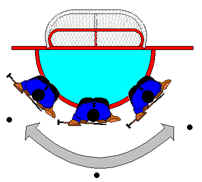
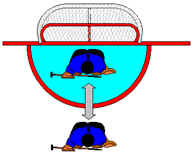
.
Each of these goal-tending basics create differences in shooting technique as well as in shooting theory. There are many other factors that we must take into consideration when combining these fundamentals with personal goal-tending preferences or style. For example a Hasik style of play is different than a Roy as is a Kirk McLean to a Garth Snow. Each particular style creates natural strengths and weaknesses from which a shooter must know so as to capitalize. When we consider that shooters may only get 3 to 8 shots a game, this information is absolutely critical. Hence the scouting report. What we cannot always determine is that where a shooting opportunity comes from coincides with the natural weakness of the goal-tender that we are facing or even our shooting strengths for that matter.. In fact the opportunity may play into the goal-tenders strength and/or our weakness.
Knowing where the puck is and how to react to create a better scoring opportunity is what we will try to do in the following paragraphs. While a whole book could be written to cover this topic (which I am know working on) I will try to condense this information so as to provide as much quality information as is possible.
A goal-tenders job at the best of times is a very difficult task. The inherent success of their position relies on the following:
1. Good positioning - take away as much of the net as possible (give the shooter as little to shoot at as possible or to create the best opportunity to stop the pucks that they cannot see - "screens")
2. Good reflexes - stop the shots that target their natural weaknesses (move equipment to puck)
3. Good anticipation - know where the puck is going as an alternate option.
4. Good vertical movement - challenge the shooter to take away as much net as possible.
5. Good horizontal movement - able to track the shooter across the goal-mouth.
6. Effective use of size - make themselves as big as possible (take up as much net as possible)
7. Good shooter read - able to read off of blade, hands, shoulders (early cues for shooting location and timing).
8. Good shooter anticipation - knowing the shooter's habits ("likes to go upstairs")
9. Exceptional concentration - aware and alert
10. Good rebound control
While there are other criteria, the above information is sufficient for our purposes.
While we can see there are many fundamental requirements for the goaltender, aside from static shooting skills (standing still), there are only 5 basic variations for the shooter attacking the net as shown below. Players combine these variations to set up scoring opportunities that complement their shooting strengths.
One constant with each example is that each specific attack style forces the goaltender to move. I will be bold enough to say that all goal-tenders have weaknesses. These weaknesses can come from either style, habit, physical deficiencies (strength, flexibility, conditioning, etc), mental (concentration, focus, cognitive) or training/practice environment.
Focusing on practice environments for example, all we have to do is to look at the North American hockey practice environment. Most coaches believe that the practice environment is for the forwards and defense, not for the benefit of the GT. How many quality shots does a GT face during practice (location, power, accuracy, etc)? How many coaches eliminate the shooter from straight line attacking the net? In my research I have found that over 95% of shooters during low pressure practice drills attack the net in a straight line as well as shoot from the "sweet spot" (low/mid slot). If this is the case then the goal-tender trains predominantly in vertical attack defense (moving out to shooter, squaring to shooting, backing into net). It is only when (in most cases) where the coach brings out a GT Coach that can focus on certain fundamentals that training becomes positional specific. However, this is still done within the team practice plan. How many GT instructors go to a coach and tell them how to run their practice so as to best benefit their GT. In over 25 years of coaching, it has never happened to me. I have asked for their advice, sure, but a direct approach, never.
These types of practice environment create habits of movement, which translates into weaknesses in alternate movement basics, or even over dominance of save application (using the glove hand all the time because players always shoot there - another similar analogy would be the weight lifter that always favors the bench press but neglects his back and/or legs; his deficiencies become very obvious to the untrained eye - so are GT deficiencies as obvious to the trained eye). What ever the case, the shooter must understand this logic. Shooting styles are designed to counter goal-tender strengths and capitalize on their weaknesses.
However, in contrast, if we look at practice habits and how they effect goal-tenders, we must do the same for the shooter. As previously mentioned, if a shooter always practices attacking the net in a straight line during practice, then certain habitual shooting techniques start to form. For example these habits can create short range shooting strengths and medium to long range shooting deficiencies. As well, deficiencies develop in stride shooting, release speed, and "drawing" skills (pulling the puck into the body before release) to mention a few.
There are basically 4 styles of shooting based on the design of the hockey stick, the "shaft and the blade".
Those styles that predominately utilize:
1. Shaft speed. (wrist shot)
2. Shaft flex (slap shot, snap shot)
3. Blade speed. (snap shot)
4. Blade flex. (slap, snap shots)
A wrist shot for example executed technically correct utilizes a combination shaft speed and blade speed while a sweep shot (most common) utilizes a combination of shaft speed and shaft flex. A slap shot primarily utilizes shaft flex.
Most shots use a combination of shaft speed and flex, and/or blade speed and flex.
I WOULD LIKE AT THIS TIME TO STATE WHAT I FEEL IS OBVIOUS! A sweep shot (which is the most often shot taught) IS NOT and I will repeat this, IS NOT a wrist shot. The wrist action in a sweep shot is minimal at best. I have many discussions about this fact with many instructors. A player can feel immediately if his wrists are involved in the shot by the feeling in the elbow of the bottom hand. A player that predominantly utilizes a sweep shot has major difficulty in performing a one-hand wrist shot. I practice training the bottom hand wrist action which plays a key role in the wrist shot.
Remember: Correct use of the stick increases power, velocity, range, deception and accuracy.
Aside from just thinking about shaft speed/flex, etc, there are other fundamentals that a goal-scorer has has to concentrate on besides the basics during game or practice play. In the following table, rate yourself on a scale of 1 - 5 with 5 being excellent.
|
Shooting fundamental |
1 | 2 | 3 | 4 | 5 |
| Velocity - Speed of shot | X | X | X | X | X |
| Accuracy - Hitting the target | X | X | X | X | X |
| Release Speed - puck away quickly | X | X | X | X | X |
| Hand Speed - putting puck into shooting position | X | X | X | X | X |
| Fakes - sell shot-deke, sell pass-shot, close/open blade, etc. | X | X | X | X | X |
| Deception - hiding shot (release technique) | X | X | X | X | X |
| Use of Screens - shooting through players | X | X | X | X | X |
| Attack Speed - skating hard to net | X | X | X | X | X |
| Rhythm - timing stick handling with GT movement | X | X | X | X | X |
| Concentration - focusing on the target | X | X | X | X | X |
| Awareness - knowing where net is and if GT is unfocused (not ready for shot - relaxed) | X | X | X | X | X |
| Attitude - shooting to score, using shot as a weapon (shooting high to get GT off-game) | X | X | X | X | X |
| Intelligence - able to read Goal-tender (strengths and weaknesses) | X | X | X | X | X |
.
Being taught how to shoot is one thing, but practicing while at home is another. Practice is essential for a player wishing to improve his score/shot ratio. Practicing should move naturally through the following progression:
1 - Mechanics first - When practicing, as the saying goes, perfect practice makes perfect. We must think of the shot as a natural extension of the body. Without correct mechanics, accuracy and velocity become a thing of chance. Shooting is really a matter of physics and mechanics. The stick is in essence a lever and the body comes the means for propelling the puck which has mass, 6 oz to be exact. It takes an incredible amount of leverage to accelerate a puck from 0 to 100 mph.
2 - Accuracy second. Pick a very small point to shoot at. Vary the height of the target point as well as the distance from which you have to shoot from. This is necessary in that it creates neuro-muscular habits that allow a player to adjust to any target and from a wide variety of distances and locations instinctively. Pick the three basic heights; high glove/blocker, five hole (just over stick), and low glove/blocker (just over stick/pad height) as well as 3 basic distances, 6-10 feet, 15-20 feet, and 30-45 feet. Take 10-20 shots to each location and at each distance. Once you have completed. Work both the backhand and forehand sides eliminating the 30-45 foot range. Once this has been completed, vary number of shots to each target (1-3) moving left and right, up and down. Next, shoot to set height and vary distance. You should get the idea now. If you find that you have a particular shot, distance or height that is a strength. take only 8-10 shots then move on to direct more of your training on your weaknesses. SHOOT WITH YOUR HEAD UP, EYES ON YOUR TARGET!!!!
3 - Velocity third. After you have warmed up using correct technique and focus, shoot as hard as you can. This helps to build shooting specific muscles. Shoot one puck, take a break, set up the puck and again shoot as hard as you can. Vary shooting styles and again, location and distance. SHOOT WITH YOUR HEAD UP
4 - Release speed third. Try to get the puck away as fast as is possible. Focus on technique first, then accuracy, then velocity. Again, this not only builds shooting specific muscle but places additional stress on you mentally so that you develop the ability to relax in pressure situations. Again, vary technique, location and distance.
Of course, this type of practice will be done while in a static shooting position (standing still). When moving to the ice surface, follow the same progression but add movement working the variety of shooting techniques while following the different offensive shooting attack lanes to both the natural and off-wing sides (diagrams above).
The following chart is an example of different types of shooting skills, albeit different variations of the same shot. However, proficiency in all of these skills enables a shooter to maximize :"Timing and Location" fundamentals.
A check list of shooting ability. Rate your technique out a mark on 1 to 5 (5 being excellent).
| Shot Type | Ranking | Shot Type |
Ranking |
||
| 1 | Wrist shot (static - weight over inside leg) | 39 | Slap shot across body - static (transfer of body weight - outside leg) | ||
| 2 | Wrist shot (static - weight over outside leg) | 40 | Slap shot - static (inside leg) | ||
| 3 | Wrist shot ( in motion over inside leg) | 41 | Slap shot off of stride (transfer of body weight across body) | ||
| 4 | Wrist shot ( in motion over outside leg) | 42 | Slap shot off of stride (shooting off of inside leg) | ||
| 5 | Wrist shot across body (transfer of weight) | 43 | Slap shot off of crossover - backhand set. | ||
| 6 | Wrist shot away from body | 44 | Slap shot while skating backwards (transfer of weight across body) | ||
| 7 | Wrist shot upstairs in close | 45 | One time slap shot off of pass while static | ||
| 8 | One time wrist shot off of pass while static (natural side pass) | 46 | One time slap shot off of pass while in motion forwards | ||
| 9 | One time wrist shot off of pass while static (off wing pass) | 47 | One time slap shot off of pass while in motion backwards | ||
| 10 | One time wrist shot off of pass while in motion (natural side) | 48 | Backhand while static | ||
| 11 | One time wrist shot off of pass while in motion (off wing pass) | 49 | Backhand while in motion | ||
| 12 | Sweep shot (static - weight over inside leg) | 50 | Backhand off of pass static | ||
| 13 | Sweep shot (static - weight over outside leg) | 51 | Backhand off of pass while in motion | ||
| 14 | Sweep shot (in motion over inside leg) | 52 | Backhand chip shot upstairs in tight | ||
| 15 | Sweep shot (in motion over outside leg) | 53 | Backhand upstairs quickly after deke | ||
| 16 | Sweep shot across body (transfer of weight) | 54 | Backhand snap shot (static) | ||
| 17 | Sweep shot upstairs in close | 55 | Backhand snap shot (motion) | ||
| 18 | Sweep shot off of natural side pass | 56 | Forehand deflection upstairs (facing out) | ||
| 19 | Snap shot pulling puck in (blade speed - static- weight over outside leg) | 57 | Forehand deflection upstairs (facing in) | ||
| 20 | Snap shot pulling puck in (blade speed - static - weight over inside leg) | 58 | Backhand deflection upstairs (facing out) | ||
| 21 | Snap shot across body pulling puck in (blade speed -transfer of weight) while in motion. | 59 | Backhand deflection upstairs (facing in) | ||
| 22 | Snap shot away from body pulling puck in (blade speed - transfer of weight) while in motion. | 60 | Forehand deflection (high/low) facing out | ||
| 23 | Snap shot pulling puck in (shaft flex - static- weight over outside leg) | 61 | Forehand deflection (high/low) facing in | ||
| 24 | Snap shot pulling puck in (shaft flex - static - weight over inside leg) | 62 | Backhand deflection (high/low) facing out | ||
| 25 | Snap shot away from body pulling puck in (shaft flex - transfer of weight) while in motion outside leg. | 63 | Backhand deflection (high/low) facing in | ||
| 26 | Snap shot off of draw- pulling puck in (shaft flex - transfer of weight) while in motion inside leg.. | 64 | Forehand upstairs quickly after deke | ||
| 27 | One time snap shot off of pass - static (natural side) | 65 | Slap shot fake away from body | ||
| 28 | One time snap shot off of pass - static (off-wing side) | 66 | Slap shot fake into body | ||
| 29 | One time snap shot off of pass - in motion (natural side) | 67 | Chip shot in close upstairs quickly | ||
| 30 | One time snap shot off of pass - in motion (off wing side) | 68 | Wrist shot while skating backwards | ||
| 31 | Snap shot (blade speed - 'Euro") upstairs quickly in tight | 69 | Snap shot while skating backwards | ||
| 32 | Snap shot (shaft flex- N.Amer.) upstairs quickly in tight | 70 | Backhand while skating backwards | ||
| 33 | Wrap-a-round forehand | 71 | Forehand flip shot (static) | ||
| 34 | Wrap-a-round backhand side | 72 | Backhand flip shot (static) | ||
| 35 | One hand wrist shot (static) | 73 | Forehand flip shot (motion) | ||
| 36 | One hand wrist shot (motion) | 74 | Backhand flip shot (motion) | ||
| 37 | One hand backhand (static) | 75 | |||
| 38 | One hand backhand (motion) | 76 |
Whew! 74 fundamentals. There are more believe it or not but just to give you an idea about the number of shooting skills that have to be mastered so as to increase your scoring potential. What about bringing the puck into a shooting position using your inside or outside skate. I can still pick top corners from above the "hash" marks using one hand while standing still or in motion (create skill when holding off a D-man). It's an advantage......allows you to still get the shot away while fighting off a checker. Difficult yes, wrist and forearm strength required, you bet, but it just creates an alternate option that just may present itself during game play that you might not have considered otherwise.
Scoring is using the right shot in the right situation. Skill, Theory and Management.
Shooting theory can be defined as skill application. When to use a wrist shot, snap shot, slap shot. What lanes to take to and away from the net to maximize shooting/scoring percentages. Shoot Management can be defined as; when to shoot relative to momentum shifts (high risk location - far side low and rim resulting in a counter), time into a shift (to tired to react to poor rebound or counter) or shot location for rebound opportunities.
In this page, I will focus on Shooting Theory based on attack methodologies.
Knowing where to put the puck off of a particular move on a particular type of goal-tender (upright, paddle down, butterfly, tall, short, reactive, thinker, etc). LOCATION, LOCATION, LOCATION. "where to put the puck when the goal-tender is moving".
How fast that the goal-tender has to move in itself is a key factor in scoring. How many times in practice (show-down) does the attacking player skate in slow with no pressure. Most of the time I expect. I try several different attack locations, distances, speeds and pressure that mimic game situations most often created by my team in game situations to give them the feel and know-how of what to do. For example:
Puck movement off a straight line attack and deke, plain and simple:
1 - Glove side to blocker side quickly - shooter's natural side to off -'wing side and (location).
2 - Glove side to blocker side quickly - shooter's off - winger side to natural side and (location).
3 - Blocker side to glove side quickly - shooter's natural side to off - wing side and (location).
4 - Blocker side to glove side quickly - shooter's off - wing side to natural side and (location).
5 - Glove side - shooter's natural side - fake pass and (location)
6 - Glove side - shooter's off - wing side - fake pass and (location)
7 - Blocker side - shooter's natural side - fake pass and (location)
8 - Blocker side - shooter's off - wing side - fake pass and (location)
Knowing where to put the puck increases chances of scoring. How many times have you seen a puck get past a goal-tender and wonder how it happened especially since there was "nothing" on the shot. Ever notice how some players seem to score effortlessly while some have to work hard at it. Location and Timing. Knowing when to shoot (knowing when a goal-tender is about to go down) and where to shoot (shooting upstairs glove side as he is going down) are the two basic goal-scoring strategies that separate the "men from the boys" so to speak.
There are 5 basic attack methodologies that utilize the above shooting criteria (location, distance, angle, speed and pressure) and they can be broken down into the following basics.
1. Linear attack - Centered attack - driving to the net
2. Horizontal attack - parallel to goal line
3. Vertical attack - perpendicular to goal-line
4. Diagonal attack
5. Wrap-a-round
Attack lanes shown below:
1. Linear Attack: Picking a straight line to the net. Shortest distance between two points.
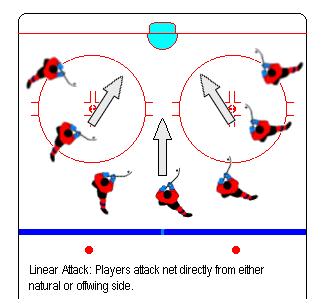
2. Horizontal attack lanes: Moving across the top of the goal-line in a parallel position.
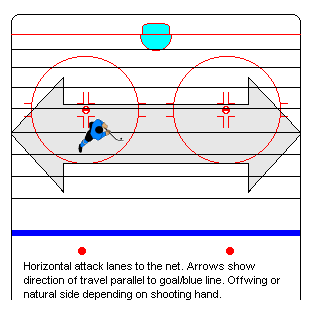
3. Vertical attack lanes: Attacking the goal-line in a perpendicular position.

4. Diagonal attack lanes: Attacking across the goal-mouth diagonally.
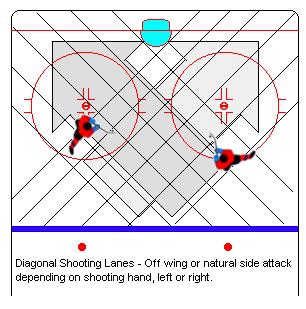
5. Wrap-a-round attack lanes: Attacking from below the goal-line.
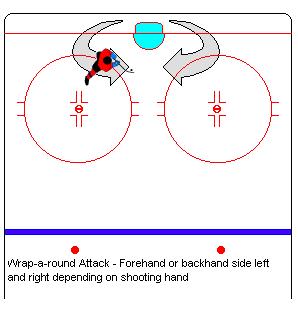
Several other intrinsic factors are involved as well: